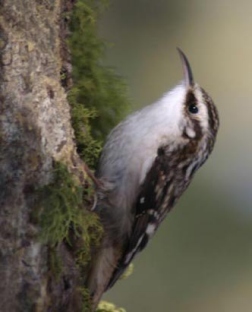|
Small, tree-clinging
bird with brown-streaked upperparts and white underparts. White line over
eye and long, decurved bill are conspicuous. Legs and feet are pink-buff.
Feeds on insects, larvae, nuts and seeds. Strong direct flights of short
duration on rapid and shallow wing beats.

|
BROWN
CREEPER
Certhia americana
PASSERIFORMES
Creeper (Certhiidae)
Range
and Habitat
Breeds from Alaska to Newfoundland and southward to the western and
northern U.S. Spends winters in breeding range and south to the Gulf
coast and Florida. Preferred habitats include deciduous and mixed woodlands.
SOUND:
"see-see-titi-see", "tsee"
Brown Creepers
will freeze when threatened, often with outspread wings, and remain
motionless for several minutes. At these times, their brown plumage
is such an effective camouflagethey can be nearly invisible.

They start at the bottom of a tree, spiral upward pecking insects as
it ascends, then hops down to the base of the next tree and begins again.
In some areas their nests often have two openings, one that serves as
an entrance and the other as an exit.
A group of creepers are collectively known as a "sleeze"
and a "spiral" of creepers.

The Brown Creeper has a large range, estimated globally at 6,500,000
kilometers. It is native to North America, El Salvador, Honduras, Guatemala,
Nicaragua, and Saint Pierre and Miquelon. This bird prefers temperate,
tropical, or subtropical climates and has an estimated global population
of 5,400,000 individuals.
|